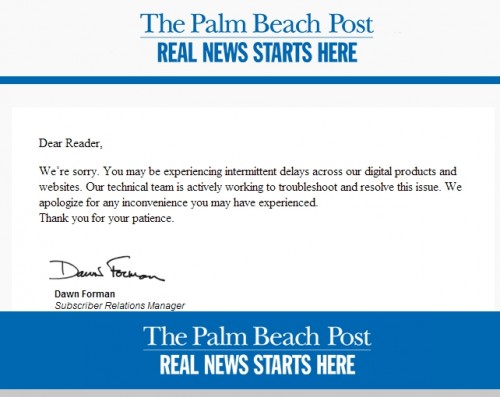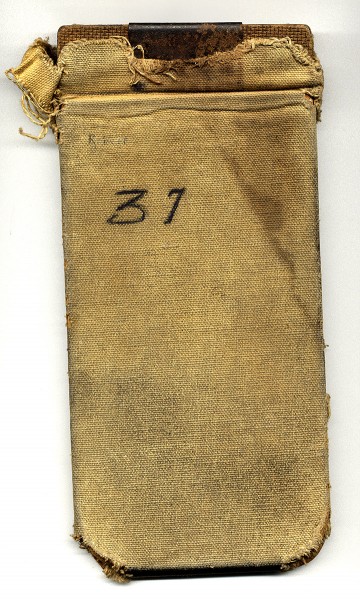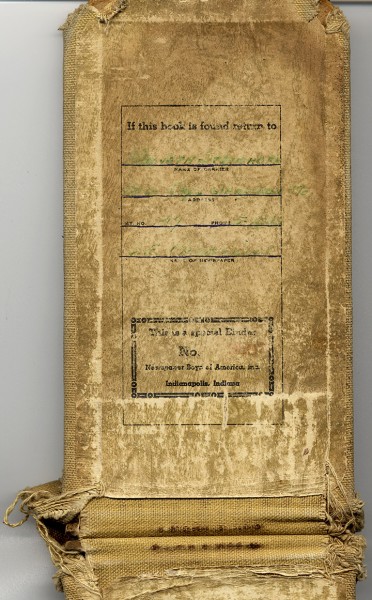 This email came from The Palm Beach Post this afternoon. That’s the place I worked for 35 years and the paper I still subscribe to (although I’m beginning to wonder why).
This email came from The Palm Beach Post this afternoon. That’s the place I worked for 35 years and the paper I still subscribe to (although I’m beginning to wonder why).
The Post was letting me know they were sorry that I might be experiencing intermittent delays across their digital products and website. They were working on fixing it, I was assured.
REAL carriers could fix their problem
 Not long after getting that email, I ran across my old Missourian collection book. That gave me a quick fix to The Post’s digital delivery problems: hire a bunch of 12-year-old kids with memory sticks to go door-to-door updating “breaking news” reports, just like we used to pitch papers in puddles in the Old Days.
Not long after getting that email, I ran across my old Missourian collection book. That gave me a quick fix to The Post’s digital delivery problems: hire a bunch of 12-year-old kids with memory sticks to go door-to-door updating “breaking news” reports, just like we used to pitch papers in puddles in the Old Days.
This was one of the earlier, and best collection books. It was made of a canvas-covered Masonite material with a heavy spring that clamped the top and bottom of the book over the sheets of yellow receipts you’d tear out and hand your customer. A later version was green and made of far lighter materials. It didn’t hold the receipts securely and would fall apart in a short period of time.
The cover has a number on it. I’m pretty sure my route number was 31 or 31A, so I’m going to guess that’s a 31, even if the number doesn’t look like it is complete.
Newspaper Boys of America, Inc.
 Inside the book is a notation that “This is a special Binder No. 9807 (?). Newspaper Boys of America, Inc. Indianapolis, Indiana.”
Inside the book is a notation that “This is a special Binder No. 9807 (?). Newspaper Boys of America, Inc. Indianapolis, Indiana.”
Dad must have filled in the ID info: it’s pretty much faded away, but I recognize his distinctive handwriting (meaning that you could read it, as opposed to my pitiful scrawl) and his use of green ink.
A quick Google search indicates that the Newspaper Boys of America, Inc, is as gone as paperboys are today. One of the few references I could find was for an N.B.A. Handbook for Newspaper Boys (second edition published in 1932) that was going for $175 in “near fine” condition. I didn’t have one of those, and if I had, my destructive younger brothers would have trashed it like they did my comic books.
I ran a photo of my carrier bag a few days back. The next trick will be to do a video showing the unique way we folded newspapers in the days before rubber bands and rolling.

I remember my book and folding the papers. I loved the customers that were P.I.A. (paid in advance)
This is a nice artifact.
The question on everyone’s lips is…where the heck did you store all that stuff from the past?
When you go to a restaurant and they have the napkin and utensils wrapped with a paper band, I remove the band and fold it like we did the Missourian. Some times it is an “icebreaker” and others at the table want to learn how to do that fold. It is simple but you would be surprised how some struggle with the fold. Besides it is good to keep up your skills, you never know when you will need them again!
I still fold scrap paper in the rectangular shape to throw! My students labeled it as my form my origami. I had one subscriber that owed me for over two years, but the Missourian wouldn’t let me quit delivering her a daily newspaper –on Pacific Street, now occupied by the Growell building.
My daddy, Weldon Stout, was a carrier for the SE Missourian in the 1920s and somewhere I have a picture of him with a group of paper boys. He is sitting and his bare feet are sticking out from under his newspaper bag.
I remember my mom paying weekly. The book with the tear-out “stamp” the proof of receipt for the transfer of money. Simple for customer and carrier to account for payment.
That was what I carried, the tear-
out stamp book.
My dad was a stickler for making me keep a real set of accounting books where every single ticket had to be accounted for. I would have been happy counting the tickets before I started collecting, then counting how many were left at the end of the day, multiplying by the weekly rate, then keeping the difference as my tips.
In the long run, though, I learned a lot about business by doing it the hard way. I don’t there is a better job for a kid than a paper route. Too bad there aren’t jobs like that out there today.